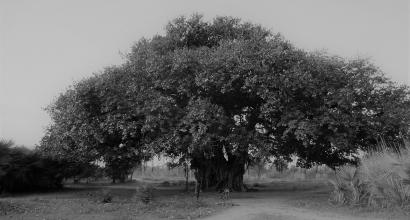Like Sawai Jai Singh, the other warrior who toiled for the cause of Sanatana Dharma during the period of the downfall of the Mughal Empire was the ideal woman Ahalyabai Holkar. Before her were women like Jijabai (Shivaji’s mother) and Yesubai, the wife of Sambhaji, Shivaji’s son. Sambhaji who was caught and imprisoned by the Mughals did not convert to Islam despite the horrific tortures he endured, and finally died a martyr. After his death, Yesubai instead of giving the throne to her young son, Sahu, displayed magnanimity by giving it up to her brother-in-law, Rajaram. Not only that, she also assisted him by giving useful advice in administrative matters and contributed immensely in organizing the Marathas. Next we have Rajaram’s wife, Tarabai. After Rajaram’s untimely death even as he was consolidating the Maratha power in all of South India, she appointed her underage son to the throne but took the administrative reins in her hand. She earned renown as a skilled practitioner of military organization and statecraft. While such women were justly famous in the Maratha circles, the one who towered over all of them and emerged as perhaps the greatest Kshatriya woman was the incomparable Ahalyabai Holkar.
Ahalyabai was born in the Chaundi Village near Aurangabad to Patel Manakoji. Although in today’s parlance we can consider her as being born in a backward class, she had imbibed a high degree of Samskara (culture). In pre-modern India, there was absolutely no paucity of and hindrance for the flowering of fundamental and lofty values of good conduct, Samskara, magnanimity, connoisseurial spirit, and spirituality on the part of every Varna (social group). Given this, no matter to which economic or social strata a person belonged, everyone, cutting across genders, had an innate awareness of the essence of the best of ancient Indian culture. It is unarguable that these values bestowed light throughout a person’s life and disseminated beauty and peace in society. If this were not so, the divine tree of Sanatana Dharma wouldn’t have survived and thrived despite facing more than a thousand years of alien attacks, and then the continuing pseudo-secularism and West-worship on the part of our own people. This tree has not withered because it stands on such firm foundations.
Thanks to divine providence, Ahalyabai became the wife of Khande Rao, the son of the powerful Maratha leader and the Subedar of Malwa, Malhari Rao Holkar. However, Malhari Rao realized that his son was addicted to sensual pursuits and was therefore unfit to be his successor. So he groomed his valourous, wise, and learned daughter-in-law in the art and craft of running a kingdom. Unfortunately, in a very short span, Ahalyabai lost her husband Khande Rao, son Male Rao, daughter Muktabai, son-in-law Yeshwant Rao, grandson Nathu and her mentor Malhari Rao, and became a widow. Isolated and unfortunate. Although her daughter and daughter-in-law had performed Sati, she decided to live for the country. She triumphed over the troubles of widowhood and the harassment at the hands of politicians and ruled for about thirty years in a manner which stunned the world. During her regime, the entire Malwa region witnessed all-round development and became culturally rich as well. It became the home for peace and happiness.
In her initial years, Ahalyabai courageously faced powerful enemies like Raghoba and Chandrachud and made a smooth path for herself. She was skilled in managing the battlefield on her own. She built a separate, all-women army contingent. When the Chandravata Rajputs underestimated her and launched a raid, she vanquished them with great ease. Ahalyabai shifted the Holkar capital from Indore to Maheshwar (this is the renowned Puranic city of Mahishmati) and built magnificent temples, divine bathing ghats, established several industries and endowed it with a place of pride on the economic and cultural map.
We can call Ahalyabai as an ideal administrator. She epitomized the virtues of a Rajarshi. Her all-encompassing competence was rooted in spirituality. She had freed her citizens from the fear of thieves, corrupt bureaucrats, famine and shortages. There was a generous supply of shelter and food for the poor and the infirm, charity and Dharma for the scholars and laymen alike and support and encouragement for noble endeavours in her kingdom. The burden of unnecessary taxes was absent. She had kept her personal character, conduct and lifestyle extremely simple and unblemished. These traits became an ideal for her subjects and raised their moral and ethical standards. She liberalized the strictures and laws related to Stridhana (inheritance of a widow), adoption, and the privileges given to widows, and stood as a beacon of light for the poor and the suffering. Although administrative officials were treated with affection, there was also a firm grip over them. Ahalyabai would personally examine administrative affairs with a thousand careful eyes so that nobody indulged in corrupt practices or neglected their duties, and instituted a solid spy system. Just as there are legends about her famed affection for her subjects, there are sagas about her compassion for loyal and honest administrative officials. She knew every detail about their joys and sorrows and their family conditions. She protected them all like a mother.
She used the four-fold tactics to subdue forest-robbers, highwaymen, and dacoits and infused them with culture and transformed them as the protectors of her dominions. On one occasion, she proclaimed that she would give her only daughter Muktabai in marriage to a warrior who was capable of subduing these outlaws. Accordingly, she took ordinary warrior, Yeshwant Rao who accomplished the feat as her son-in-law. This shows her constant commitment to the welfare of her people. The Bhils, hunters, forest-robbers and related bands in the vicinity of the Vindhyachala region surrendered to her.
Ahalyabai was unrivalled in the manner in which she dispensed justice. She was also peerless in upholding the truth, getting things done quickly, meting out the appropriate punishment and in her innate compassion. From petty domestic quarrels to grave disputes, Ahalyabai resolved all issues in a manner that was agreeable to everyone. This intelligence and shrewdness was also tinged with affection.
She put great emphasis on agriculture, cattle-rearing and commerce. She was an accomplished practitioner of criminal jurisprudence. She did not mass up her military force unnecessarily and at the same time, ensured that there was no shortage of anything with respect to her battle-ready forces. During war, she would herself mount the horse brandishing her sword and led from the front. She never invaded other kingdoms but simultaneously protected her kingdom from invasions and maintained her independence. This was truly the ideal of Sanatana Dharma and that of the emperors of Bharata.
Ahalyabai ensured that her treasury was always full, overflowing. The Malwa region was among the richest during her reign. She didn’t waste a single rupee for anything other than for her people’s welfare. Not even for herself. Indeed, she kept an auspicious Bilwa leaf (the favourite of Lord Shiva) and swearing on it, dedicated the entire sum of the whopping sixteen crore rupees in her personal treasury for the welfare of her country. She performed numerous acts of charity and Dharma throughout India. This is a preeminence that has survived till date evoking our astonishment and respect.
To be continued















































